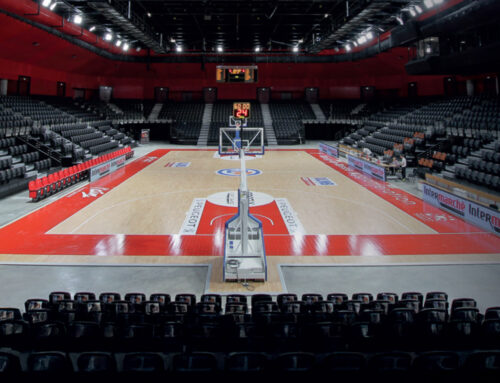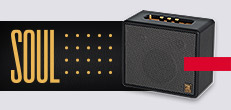Sports halls are multifunctional spaces that host a wide variety of events, from basketball or football matches to concerts or conferences. Public address systems play a key role in these venues, amplifying the announcer’s voice, music and other sounds so that they can be heard by all attendees. A good PA installation for sports halls is essential to ensure an optimal listening experience for everyone present.
Steps to optimise the public address system in a sports hall
Ward needs assessment
The first step in optimising PA for sports halls is to conduct a thorough assessment of the specific needs of the facility. This involves considering factors such as:
- Hall dimensions: The size of the hall is a determining factor in the power and number of loudspeakers required.
- Type of events: The nature of the events taking place in the hall will determine the type of sound required. For example, sports matches require clear speech intelligibility, while concerts require high-fidelity audio reproduction.
- Budget: The budget available for public address investment is an important factor in making decisions about equipment and installation.
- Acoustic regulations: It is important to comply with local and national acoustic regulations to ensure a pleasant and safe listening experience for the audience.
Selection of appropriate equipment
Once the needs of the hall have been assessed, the appropriate equipment must be selected to ensure uniform coverage and optimum sound quality. The main components of a public address system for sports halls include:
- Speakers: Speakers should be selected according to the size of the hall, the type of event and the available budget. There are different types of loudspeakers, such as column, ceiling and in-wall speakers, each with their own characteristics and applications.
- Amplifiers: Amplifiers provide the power needed to drive the loudspeakers. The power of the amplifier must be adequate for the number of speakers and the size of the hall.
- Mixing desk: The mixing console allows control of the different sound sources, such as microphones, music players and external audio signals.
- Microphones: Microphones should be selected according to the type of use they will be put to. For example, dynamic microphones are suitable for speech, while condenser microphones are ideal for capturing music.
- Sound processors: Sound processors allow the audio quality to be improved by techniques such as equalisation, compression and limiting.
Design of the installation
- Speaker placement: Speaker placement is critical to ensure uniform sound coverage throughout the hall. In general, it is recommended to place the loudspeakers on the side walls of the hall, at a height of between 3 and 5 metres.
- Loudspeaker height: The height of the loudspeakers in the PA system for sports halls should be adequate for the sound to reach all attendees, regardless of their height. In general, a height of between 3 and 5 metres is recommended.
- Sound orientation: The orientation of the sound is also important to ensure good intelligibility. In general, it is recommended to orient the speakers towards the centre of the hall.
Hall acoustics
- Reverberation time: Reverberation time is the time it takes for the sound to die out after it has stopped being emitted. Excessive reverberation time can cause the sound to be garbled and difficult to understand. In general, a reverberation time of 1-2 seconds is recommended for sports halls.
- Echoes: Echoes are reflections of sound that occur when sound bounces off the surfaces of the hall. Echoes can cause the sound of the PA system for sports halls to be distorted and difficult to understand. It is important to eliminate echoes through acoustic treatments such as sound absorbing panels or sound diffusers.
Sound system configuration
The configuration of the sound system in the PA system for sports halls is a crucial process to optimise the audio quality and ensure a pleasant listening experience for all attendees. Among the aspects to be configured are:
- Equalisation: Equalisation allows the frequency balance of the sound to be adjusted to suit the acoustic characteristics of the hall and the type of event.
- Volume levels: Volume levels must be carefully adjusted to ensure adequate speech intelligibility and a comfortable sound pressure level for the audience.
- Audio delay: Audio delay is necessary in large halls to avoid the echo effect, which occurs when sound bounces off the walls and reaches the attendees’ ears with a slight delay.
Preventive maintenance
Regular preventive maintenance of the public address system for sports halls is essential to ensure its proper functioning and to prolong its service life. Preventive maintenance includes tasks such as:
- Cleaning the speakers: Regular cleaning of the speakers prevents the build-up of dust and dirt that can affect the sound quality.
- Checking connections: It is important to periodically check the connections to detect possible faults that may affect the operation of the system.
- System calibration: It is recommended to calibrate the public address system at least once a year to ensure optimum sound quality.
Conclusion
Optimising public address for sports halls is a complex process that requires careful assessment of the facility’s needs, selection of the right equipment and strategic distribution of loudspeakers. The acoustics of the hall also play an important role in the sound quality. In addition, regular maintenance of the public address system is essential to ensure its proper functioning and prolong its life.
Fonestar is a leader in communication technologies, and offers multiple public address solutions for sports facilities. Contact us to find out which equipment is best suited to your centre, and we will help you to optimise its sound.





